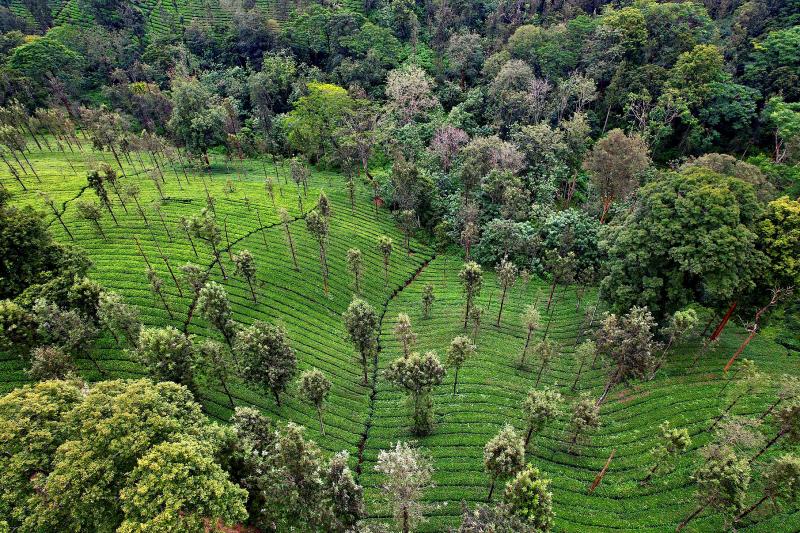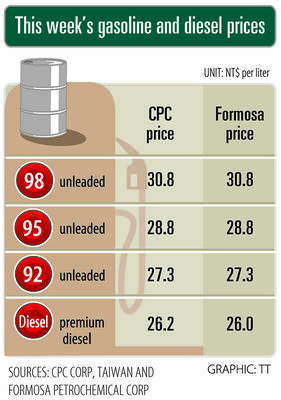P. K. Madhavan stood proudly next to a young, sturdy mahogany tree, one of 100 he planted three years ago on his farm in Wayanad District in the southern Indian state of Kerala.
Madhavan’s 0.8 hectares of land in Meenangadi village used to be lush with cash crops — coffee, black pepper and betel nut — but two decades of drought and unseasonally heavy rain have decimated his yields.
Now the mahogany plantation is one of his only reliable sources of income, earning him up to 5,000 rupees (US$67) a year — and all he has to do is keep the trees standing.

Photo: AFP
The 84-year-old farmer is being paid to plant and protect trees through a “tree banking” scheme, the project at the heart of Meenangadi’s campaign to become India’s first carbon-neutral village.
Madhavan got his saplings free of charge from Meenangadi’s panchayat, or village council, which has pledged lend him 50 rupees per tree for every year he does not cut it down until 2031.
At that point, the loan is written off and he can do what he likes with the trees, including felling them to sell for timber.
“Every morning, I spend some time looking after these trees. I am really happy to say that except for three [which died naturally], all are steadfastly growing,” Madhavan said. “Sooner or later, my land will become a small forest filled with infinite greenery.”
Over the past decade, Kerala’s farmers have faced rising temperatures and erratic rains, while deforestation has caused soil degradation, making their land more vulnerable to flooding and mudslides.
Wayanad District is suffering more than most, with the Kerala State Action Plan on Climate Change naming it as one of the state’s four hotspots.
Tree-planting initiatives are taking root worldwide as governments and corporations look for ways to cut planet-warming emissions, and fight pollution and land degradation — or simply to earn credits to offset their carbon emissions.
However, many projects fail when they rely on locals with little time or money to look after newly planted trees.
Meenangadi’s tree-banking project avoids that pitfall by giving farmers an ongoing incentive to protect trees, said C. Jayakumar, executive director of Thanal, a local environmental group helping implement the village’s carbon-neutral program.
“The message here is that climate change is being linked with climate justice,” he said. “Usually, it will take a farmer one or two decades to get the financial benefits of planting a timber tree sapling. With this project, the farmer gets money from the start.”
MONEY GROWS ON TREES
When Meenangadi started its carbon-cutting journey in 2016, an energy audit indicated the village population of 33,450 was generating 15,000 tonnes of excess carbon every day.
To help bring that number down to zero within the next four years, the aim is to plant at least 350,000 trees to soak up carbon dioxide from the atmosphere, said K.E. Vinayan, president of the village council.
A farmer who joins up is given tree saplings grown in the council’s nursery or donated by the Kerala Forest Department.
Ranging from trees for timber and fruit to bamboo, most are native species chosen for their ability to absorb large amounts of carbon and withstand wild weather swings, as well as to generate an income for farmers once they mature, Vinayan said.
Three years after planting, the farmer can mortgage the trees for a 10-year interest-free loan from the council, which only has to be paid back if any of the trees are cut down.
If a tree dies due to disease, heavy rain or drought, the farmer continues to receive money for it, Vinayan added.
So far, 780 farmers have enrolled in the scheme, and the village has planted 172,000 saplings, including on vacant lots and those handed out to farmers who support the net-zero push but do not want to join the tree-banking project.
It has already distributed 350,000 rupees in the first tranche of loans, with the second tranche coming soon, boosted by a 100 million-rupee grant from Kerala state.
While a first survey is still under way, Vinayan said that as far as he knows, none of the trees have been cut down.
Yet it is vital that farmers be allowed to use their trees however they want at the end of their loan period, because “they are the real owners and custodians of the trees,” he said. “We don’t want to permanently infringe on their rights.”
The council plans to regularly review the project with a view to extending the mortgage period or launching a new scheme to incentivize farmers to preserve their plantations, he added.
VILLAGE INSPIRATION
Even if most farmers joining Meenangadi’s project decide to leave their trees standing, many environmentalists say that tree-planting drives are not nearly enough to slow planetary warming.
G. Balagopal, an environmentalist and committee member of scientific organization Kerala Sasthra Sahithya Parishad, said he supported the tree-banking scheme, but it had limitations.
“Climate change is a global phenomenon — it can’t be mitigated by massive tree-planting in a particular region,” he said.
The benefits of planting trees are canceled out if the carbon they pull from the air is replaced by greenhouse gases coming from vehicles, household heating and power sources, he said.
“The need of the hour is new [green] technology like solar,” he added.
Meenangadi council members said they are looking at other ways to bring down carbon emissions, including shifting to solar lighting and electric vehicles, and using high-efficiency stoves.
The village’s climate ambitions are also spreading. The governing council for Sulthan Batheri Block, the district sub-division where Meenangadi is located, launched its own net-zero program last month.
“Meenangadi’s carbon-neutral mission has really inspired us,” said C. Assainar, president of the Sulthan Batheri Block Panchayat.
For Madhavan in Meenangadi, the village’s plan offers hope that he and his fellow farmers can help calm the erratic weather that has turned Wayanad District from an agricultural champion to a region in crisis.
“I hope the ongoing carbon-neutral campaign will help us recapture our past glory,” he said.

SETBACK: Apple’s India iPhone push has been disrupted after Foxconn recalled hundreds of Chinese engineers, amid Beijing’s attempts to curb tech transfers Apple Inc assembly partner Hon Hai Precision Industry Co (鴻海精密), also known internationally as Foxconn Technology Group (富士康科技集團), has recalled about 300 Chinese engineers from a factory in India, the latest setback for the iPhone maker’s push to rapidly expand in the country. The extraction of Chinese workers from the factory of Yuzhan Technology (India) Private Ltd, a Hon Hai component unit, in southern Tamil Nadu state, is the second such move in a few months. The company has started flying in Taiwanese engineers to replace staff leaving, people familiar with the matter said, asking not to be named, as the

The prices of gasoline and diesel at domestic fuel stations are to rise NT$0.1 and NT$0.4 per liter this week respectively, after international crude oil prices rose last week, CPC Corp, Taiwan (台灣中油) and Formosa Petrochemical Corp (台塑石化) announced yesterday. Effective today, gasoline prices at CPC and Formosa stations are to rise to NT$27.3, NT$28.8 and NT$30.8 per liter for 92, 95 and 98-octane unleaded gasoline respectively, the companies said in separate statements. The price of premium diesel is to rise to NT$26.2 per liter at CPC stations and NT$26 at Formosa pumps, they said. The announcements came after international crude oil prices

DOLLAR SIGNS: The central bank rejected claims that the NT dollar had appreciated 10 percentage points more than the yen or the won against the greenback The New Taiwan dollar yesterday fell for a sixth day to its weakest level in three months, driven by equity-related outflows and reactions to an economics official’s exchange rate remarks. The NT dollar slid NT$0.197, or 0.65 percent, to close at NT$30.505 per US dollar, central bank data showed. The local currency has depreciated 1.97 percent so far this month, ranking as the weakest performer among Asian currencies. Dealers attributed the retreat to foreign investors wiring capital gains and dividends abroad after taking profit in local shares. They also pointed to reports that Washington might consider taking equity stakes in chipmakers, including Taiwan Semiconductor

A German company is putting used electric vehicle batteries to new use by stacking them into fridge-size units that homes and businesses can use to store their excess solar and wind energy. This week, the company Voltfang — which means “catching volts” — opened its first industrial site in Aachen, Germany, near the Belgian and Dutch borders. With about 100 staff, Voltfang says it is the biggest facility of its kind in Europe in the budding sector of refurbishing lithium-ion batteries. Its CEO David Oudsandji hopes it would help Europe’s biggest economy ween itself off fossil fuels and increasingly rely on climate-friendly renewables. While